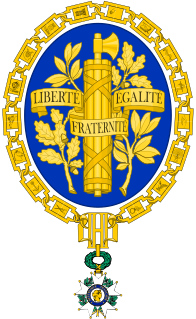
Back Escudo de Francia AN شعار فرنسا Arabic شعار فرنسا ARZ Emblema nacional de Francia AST Fransa gerbi Azerbaijani Герб Францыі Byelorussian Нацыянальны сымбаль Францыі BE-X-OLD Емблема на Франция Bulgarian ফ্রান্সর চিনত্হান BPY Ardamezioù Frañs Breton
| Unofficial coat of arms of France | |
|---|---|
 | |
| Versions | |
 | |
| Armiger | French Republic |
| Adopted | 1905[3] |
| Crest | Wreath |
| Shield | Azure, a lictor's fasces palewise upon two branches, of oak and of laurel, crossed in saltire, all or, surmounted by a ribbon of the same charged with the motto in letters sable: "LIBERTÉ, ÉGALITÉ, FRATERNITÉ" |
| Order(s) | Star and grand collar of the Legion of Honour (current version since 1953) |
| Earlier version(s) | See history |
The coat of arms of France is an unofficial emblem of the French Republic. It depicts a lictor's fasces upon branches of laurel and oak, as well as a ribbon bearing the national motto of Liberté, égalité, fraternité. The full achievement includes the star and grand collar of the Legion of Honour. This composition was created in 1905 (during the Third Republic) by heraldic painter-engraver Maurice de Meyère,[4] and it has been used at the Foreign Ministry during state visits and for presidential inaugurations.
The country is traditionally associated with the fleurs-de-lis design, which came into use by French kings during the High Middle Ages. This design still represents France and the House of Bourbon in the form of marshalling, such as in the arms of Spain, Quebec, and Canada. The fleur-de-lis was also the symbol of Île-de-France, the core of the French kingdom.
The only national symbol specified in the present constitution is the tricolour flag, i.e. in Article 2.[5]
- ^ "FranFrance". Archived from the original on 2018-07-05.
- ^ "Réception d'Emmanuel Macron à l'Hôtel de ville de Paris". 18 May 2017. Archived from the original on 22 March 2019. Retrieved 25 February 2019.
- ^ "Les symboles de la République française". Site de la présidence de la République. 21 October 2015.
- ^ https://gallica.bnf.fr/ark:/12148/bpt6k4657709x/f1.item.r=%22%20D'azur,%20au%20faisceau%20de%20licteur%20posé%20en%20pal%22.zoom
- ^ Article II of the Constitution of France (1958)
© MMXXIII Rich X Search. We shall prevail. All rights reserved. Rich X Search